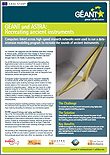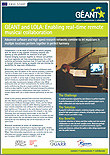Introduction
The spread of technology into research and education is continually accelerating. While ten years ago powerful computers were mainly used in science and medical projects digital technology is now equally important for the arts and sciences.
Critial to teaching and research
Sharing digital information such as images of source materials like manuscripts, paintings or artefacts is now critical to both teaching and research, enabling many more people to experience the arts and culture without having to travel vast differences.
Collaboration between experts has been made easier by techniques such as video conferencing that enable lectures and symposia to be broadcast across the globe. Artists can now work, play and perform together in real time irrespective of location, breaking down cultural barriers and enabling many more people to enjoy the arts and music.
The application of large scale computing power also allows researchers to recreate the past, building virtual models of buildings, objects and even instruments that no longer survive. This provides a window into history that can be used to increase our knowledge and understanding of the past through new breakthroughs.
The impact of research and education networks
Digitising content, whether it is a high definition artistic performance, an electronic archive of historical records or a virtual model of a long since vanished object creates extremely large computer files. Sharing these between researchers and students across the globe consequently requires high bandwidth and high capacity research and education networks, such as GÉANT, as they are simply too large to be cost-effectively transmitted across the commercial internet.
The processing power required for creating computer models, such as of vanished instruments in the ASTRA project, is often too great for a single site, leading to the use of grids of high performance computers that share the workload between them. To link these geographically spread resources, grids rely on high speed research networks to seamlessly transfer data in real time.
Whether performing or delivering collaborative lectures, artists and teachers need to be able to work together in real-time, undisturbed by delays or downtime. Only research and education networks can provide these guaranteed, high capacity connections that let geographically spread performers work together as if they were in the same space.
Click here for more details and case studies on some of the leading global projects that GÉANT is involved with:



